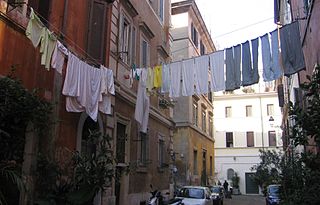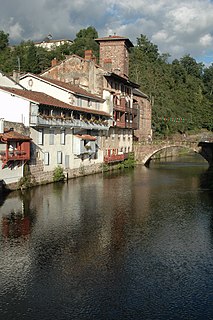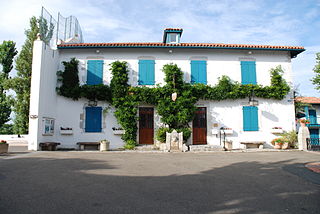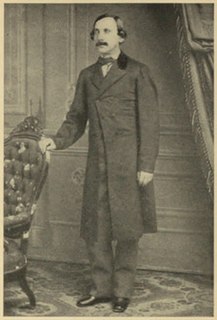
Turlock is a city in Stanislaus County, California, United States. Its estimated 2019 population of 73,631 made it the second-largest city in Stanislaus County after Modesto.

Hygiene is a series of practices performed to preserve health. According to the World Health Organization (WHO), "Hygiene refers to conditions and practices that help to maintain health and prevent the spread of diseases." Personal hygiene refers to maintaining the body's cleanliness.

Laundry refers to the washing of clothing and other textiles. Laundry has been part of history since humans began to wear clothes, so the methods by which different cultures have dealt with this universal human need are of interest to several branches of scholarship. Laundry work has traditionally been highly gendered, with the responsibility in most cultures falling to women. The Industrial Revolution gradually led to mechanized solutions to laundry work, notably the washing machine and later the tumble dryer. Laundry, like cooking and child care, is still done both at home and by commercial establishments outside the home.

A clothes iron is a small appliance that, when heated, is used to press clothes to remove creases. Domestic irons generally range in operating temperature from between 250 °F (121 °C) to 360 °F (182 °C). It is named for the metal (iron) of which the device was historically made, and the use of it is generally called ironing, the final step in the process of laundering clothes. Ironing works by loosening the ties between the long chains of molecules that exist in polymer fiber materials. With the heat and the weight of the ironing plate, the fibers are stretched and the fabric maintains its new shape when cool. Some materials, such as cotton, require the use of water to loosen the intermolecular bonds.

A mangle or wringer is a mechanical laundry aid consisting of two rollers in a sturdy frame, connected by cogs and, in its home version, powered by a hand crank or electricity. While the appliance was originally used to wring water from wet laundry, today mangles are used to press or flatten sheets, tablecloths, kitchen towels, or clothing and other laundry.

Saint-Jean-Pied-de-Port is a commune in the Pyrénées-Atlantiques department in south-western France close to Ostabat in the Pyrenean foothills. The town is also the old capital of the traditional Basque province of Lower Navarre. Saint-Jean-Pied-de-Port is also a starting point for the French Way Camino Francés, the most popular option for travelling the Camino de Santiago.

The French Laundry is a French and New American restaurant located in Yountville, California, in the Napa Valley. The chef and owner of the French Laundry is Thomas Keller. The restaurant building dates from 1900 and was added to the list of National Register of Historic Places in 1978.
Aviron Bayonnais, commonly called Bayonne, is a French rugby union club from Bayonne in Pyrénées-Atlantiques which, for the 2016-17 season, competed in the top tier of the French league system, in the Top 14 competition. In the 2015–16 Rugby Pro D2 Season they were promoted after finishing 2nd and winning the playoff final against Aurillac. In the 2016-2017 season, they finished in last place, and will be relegated back to Pro D2 for the 2017-18 season. Founded in 1904, they play at the Parc des Sports also known as Jean Dauger in Bayonne. Their mascot is a pottok pony called pottoka. They have ties to the French Basque community.
Linens are fabric household goods intended for daily use, such as bedding, tablecloths and towels. "Linens" may also refer to church linens, meaning the altar cloths used in church.

Arcangues is a commune in the Pyrénées-Atlantiques department in the Nouvelle-Aquitaine region of southwestern France in what was formerly the Basque province of Labourd.

A self-service laundry, coin laundry, laundromat or coin wash is a facility where clothes are washed and dried without much personalized professional help.

Aubertin is a commune in the Pyrénées-Atlantiques department in the Nouvelle-Aquitaine region of south-western France.

Arzacq-Arraziguet is a commune in the Pyrénées-Atlantiques department in the Nouvelle-Aquitaine region of south-western France.

Arudy is a commune in the Pyrénées-Atlantiques department in the Nouvelle-Aquitaine region of south-western France.

Abitain is a commune in the Pyrénées-Atlantiques department in the Nouvelle-Aquitaine region in southwestern France.
The Chinese Hand Laundry Alliance (CHLA) is a labor organization formed in 1933 to protect the civil rights of overseas Chinese living in North America and "to help Chinese laundry workers break their isolation in American society." An openly left-wing organization, the CHLA used various means — including the slogans "To Save China, To Save Ourselves" and "Resist Japan and Save China” — to oppose the Japanese invasion of Manchuria.
Soon Hing v. Crowley, 113 U.S. 703 (1885), was a case decided by the Supreme Court of the United States.

Solomon Lazard, also known as S. Lazard, (1827–1916) was an entrepreneur in 19th century Los Angeles, California, a member of the city council there in 1854 and in 1861–62 and, some say, the founder of the international banking firm Lazard Frères and Company.

De strijkster is a painting by Rik Wouters in the Royal Museum of Fine Arts Antwerp. It is one of many scenes from daily life from which the painter found inspiration and took as a subject. His wife, muse and favourite model was Hélène Duerinckx (Nel).
















